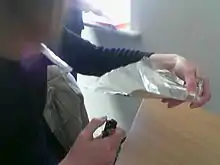Chasing the dragon
"Chasing the dragon" (CTD) (traditional Chinese: 追龍; simplified Chinese: 追龙; pinyin: zhuī lóng; Jyutping: zeoi1 lung4), or "foily" in Australian English,[1] refers to inhaling the vapor of a powdered psychoactive drug off a heated sheet of aluminum foil. The moving vapor is chased after with a tube (often rolled foil) through which the user inhales.[2] The "chasing" occurs as the user gingerly keeps the liquid moving in order to keep it from overheating and burning up too quickly, on a heat conducting material such as aluminium foil.

Another use of the term "chasing the dragon" refers to the elusive pursuit of a high equal to the user’s first in the use of a drug, which after acclimation is no longer achievable.[3] Used in this way, “chasing the dragon” can refer to any recreational drug administered by any means.
Etymology
Chasing the dragon is a slang phrase of Cantonese origin from Hong Kong. The Hong Kong film Chasing the Dragon is named from the origin of the etymology.
Cultural aspects
Aluminum foil is considered to be low-quality drug paraphernalia. It is commonly associated with drug abuse. Hard drugs that are commonly inhaled this way include but are not limited to morphine, heroin, fentanyl, oxycodone, opium, and ya ba (a pill containing caffeine and methamphetamine).
Risks
It is always harmful to expose the lungs to any kind of smoke or heated vapor.[4]
Drug overdose
A drug overdose caused by chasing the dragon is hard to predict because this technique does not deliver a standardized dosage. It is virtually impossible even for skilled users to know how much of the substance has been evaporated, burned, and inhaled. These combined factors may create a false sense of security when a given dose seems safe to repeat, but may cause an overdose when all the factors are randomly excluded.
A vaporizer is a safer drug paraphernalia than aluminum foil.
Lung cancer from natural talc
Talc is an excipient often used in pharmaceutical tablets. Also, illicit drugs that occur as white powder in their pure form are often cut with cheap talc. Natural talc is cheap but contains asbestos while asbestos-free talc is more expensive. Talc that has asbestos is generally accepted as being able to cause lung cancer if it is inhaled. The evidence about asbestos-free talc is less clear, according to the American Cancer Society.[5]
Talc can be avoided by dissolving the substance in water, filtering and discarding non-dissolving particles with a syringe, and evaporating the water of the dissolved substances.
Advantages
Vaporizing significantly decreases or eliminates certain risks of heroin use, such as the transmission of HIV, hepatitis, and other blood-borne diseases through needle sharing, the introduction of skin bacteria to the bloodstream due to non-sterile injection, and the stress that injection puts on veins. However, a professional vaporizer eliminates the risks associated with chasing the dragon.
Oral administration may also eliminate these risks, but the high is much less intense and longer.
References
- foily. ISBN 978-0-19-982994-1. Retrieved 10 January 2017.
- Strang, John; Griffiths, Paul; Gossop, Michael (June 1997). "Heroin smoking by 'chasing the dragon': origins and history". Addiction. 92 (6): 673–684. doi:10.1046/j.1360-0443.1997.9266734.x. PMID 9246796.
- "What Does It Mean To "Chase The Dragon"?". Serenity Oaks Wellness. 16 May 2018.
- Gorguner, Metin; Akgun, Metin (2010). "Acute Inhalation Injury". The Eurasian Journal of Medicine. 42 (1): 28–35. doi:10.5152/eajm.2010.09. PMC 4261306. PMID 25610115.
- "Talcum Powder and Cancer". www.cancer.org.
- Offiah, C.; Hall, E. (February 2008). "Heroin-induced leukoencephalopathy: characterization using MRI, diffusion-weighted imaging, and MR spectroscopy". Clinical Radiology. 63 (2): 146–152. doi:10.1016/j.crad.2007.07.021. PMID 18194689.
- Buxton, Jane A; Sebastian, Renee; Clearsky, Lorne; Angus, Natalie; Shah, Lena; Lem, Marcus; Spacey, Sian D (2011). "Chasing the dragon - characterizing cases of leukoencephalopathy associated with heroin inhalation in British Columbia". Harm Reduction Journal. 8 (1): 3. doi:10.1186/1477-7517-8-3. PMC 3035193. PMID 21255414.
- Hughes, S.; Calverley, P. M. (10 December 1988). "Heroin inhalation and asthma". BMJ. 297 (6662): 1511–1512. doi:10.1136/bmj.297.6662.1511. PMC 1835195. PMID 3147049.
- Krantz, Anne J.; Hershow, Ronald C.; Prachand, Nikhil; Hayden, Dana M.; Franklin, Cory; Hryhorczuk, Daniel O. (February 2003). "Heroin Insufflation as a Trigger for Patients With Life-Threatening Asthma". Chest. 123 (2): 510–517. doi:10.1378/chest.123.2.510. PMID 12576374. S2CID 14206292.
- Levine, Michael; Iliescu, Maria Elena; Margellos-Anast, Helen; Estarziau, Melanie; Ansell, David A. (October 2005). "The Effects of Cocaine and Heroin Use on Intubation Rates and Hospital Utilization in Patients With Acute Asthma Exacerbations". Chest. 128 (4): 1951–1957. doi:10.1016/S0012-3692(15)52588-9. PMID 16236840.